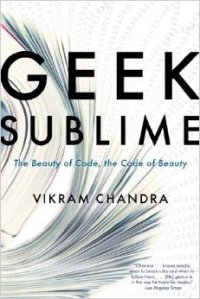[Crossposted at HASTAC.org]
I’m in the process of reading Geek Sublime: The Beauty of Code, the Code of Beauty by Vikram Chandra. While I plan to post a full review when I’m finished, I thought I’d start a short series in which I blog through my reading of the book.
A theme that has already emerged with great force in the book is that of crossings—crossings of cultures, of histories, of languages—and the theme allows Chandra to link together, often in unexpected ways, his personal biography, the larger history of programming, and a discussion of the mechanics of computer languages. Indeed, what drew me to Chandra’s book—beyond the fact that anything called “Geek Sublime” is likely to catch the eye of a Romanticist with DH interests—was Chandra’s relatively unique position as both a fiction writer and a programmer.
His fourth chapter explores his experience of another dual identity, one which emerged as he moved from his hometown of Bombay to an MFA program in the US:
I was moving between cultures, from India to America and back. I was a wanderer between nation states, I negotiated my way through their rigid borders and bureaucracies, and what could be more modern than that? I was surely a postmodern lover of modernist fiction. Yet, in my creative urges, in the deepest parts of myself, I also remained somehow stubbornly premodern. I didn’t use those premodern forms only for political and polemical reasons; I wasn’t only trying to ironize psychological “realism” by placing it next to the epic and the mythical, or only to create lo real maravilloso as a critique of bourgeois Western imperial notions of the real. No, the impulse was not merely negative. This multiply layered narrative was how I lived within myself, how I knew myself, how I spoke to myself. There was the modern me, and also certain simultaneous selves who llved on alongside. (41-42)
The chapter then turns to a cultural shift within programming culture itself: from its perception as an activity that was “more handicraft than science, more feminine than masculine, more mechanical than intellectual” (50) and which was carried out principally by women to the re-definition of programming—especially coding directly in machine code—as an inherently masculine, even “macho,” activity of pure intellectual creation.
But Chandra’s book is not only attuned to the crossings (and sometimes doublecrossing) in the experiences of writing and coding, he also demonstrates the multilayered nature of coding itself. In his third chapter (its succinct and clarifying description of the basic mechanics of computer languages is by itself worth the price of the book) he explains both the underlying digital logic of machine code and demonstrates how the high-level programming languages in which most programmers work today are in fact part of a “stack of languages” (37) and a complex network of translation. As a programmer, Chandra asserts, he works in “an orderly, simplified hallucination, a maya that is illusion and not-ilusion—the code I write sets off other subterranean incantations which are completely illegible to me” (40).

